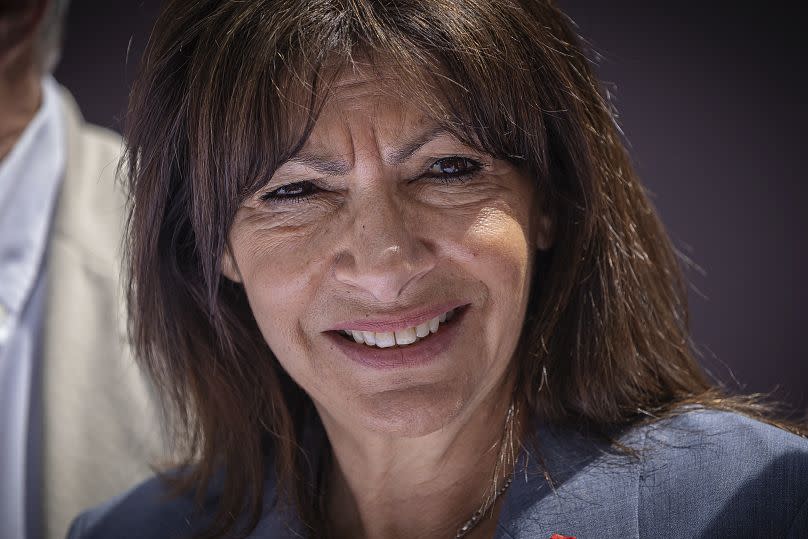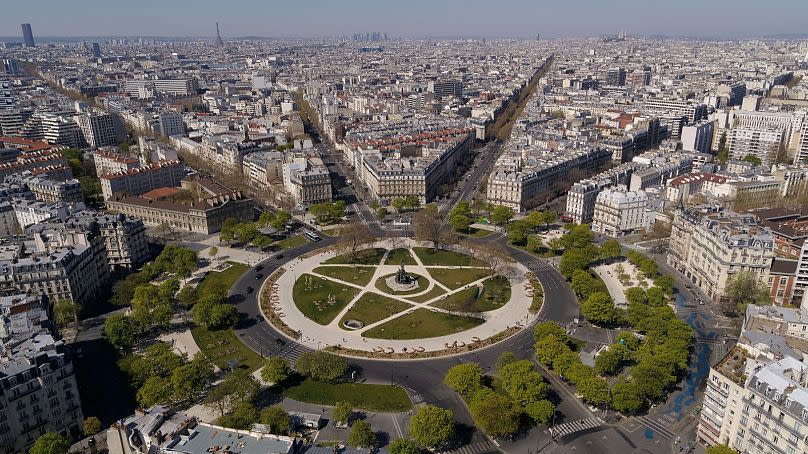‘The time of the whole car city is over’: How is Paris encouraging walking and cycling?

It’s a beautiful day for it. The sun bounces off the white squares of the picnic cloth which runs from the Arc de Triomphe to Avenue George V. Traffic lights are still turning from red to green, conducting no one.
Elodie and her partner are among 4,000 lucky ticket-holders to the free grand pique-nique des Champs-Élysées held on 26 May. They’re enjoying the novelty of relaxing on the road that they usually cycle down for work, dodging cars and selfie-absorbed tourists.
“We are Parisian, and this is a place we have been driven out of,” says the 51-year-old writer. “It’s not a museum, not Emily in Paris or Disneyland.”
It’s an understandable sentiment, but the scene is almost theatrically French. Before thousands of guests take their places, the head chef poses proudly in spotless whites, while men from the Champs-Élysées committee tell reporters that picnics are a treasured national pastime.

Among them walks Anne Hidalgo, Paris’s green-crusading mayor, smiling and shaking hands with chefs at the food trucks. The council she heads up didn’t organise this private event, but it’s apiece with her vision for the city - tackling pollution and reimagining streets for pedestrians and cyclists.
The Arc De Triomphe has played backdrop to various such events over the years, including the annual car-free day Hidalgo inaugurated in 2015. And with the city hosting the Olympics this summer, the council is looking to show its green initiatives in the best light.
“We see it as a way to show to the world a vision of a new way to host the games, and a vision to live in the city by 2040 [under] climate change,” a spokesperson for the city hall tells Euronews Green. Here’s what’s changing in the city of lights.
5. Parisians are getting on two wheels
Making your way into Paris from the Gare du Nord, you’ll see reams of dedicated green bike lanes running alongside traffic, not unlike in Amsterdam.
Paris now boasts more than 1,300 kilometres of bicycle lanes, 500 kilometres of which were rolled out between 2014 to 2020. 30 km worth of new lanes have been added both in and outside the city centre for the Olympics.
That has involved some joined-up thinking from the city hall - which only controls the inner city of Paris - and suburban mayors. In some cases literally making sure cycle lanes continue on the same side of the road.
Communication is key, says the spokesperson from deputy mayor Emmanuel Grégoire’s team. “The best way to explain to people is to show that we’re not making life harder,” he says. Driving a car in Paris requires a lot of patience; by contrast, cycling is quick - and safe, as the rise in lanes means people aren’t lost in an “ocean of cars”.
“We have to help children learn to bike in schools and take the time to explain to people that the time of the whole car city is over,” he adds.
The message seems to be getting through. More Parisians now cycle than drive through the centre, according to a recent study from urban planning agency Institut Paris Region.
4. Pedestrianising streets and squares
There are still some teething issues with turning Paris into a fully cyclable city. But with its close-knit arrondissements, it's always been a walkable one.
Pedestrians have been granted more room in recent years. In 2013 and 2016 respectively, the city hall banned traffic from the left and right banks of the Seine.
Place de la Nation, which used to be a roundabout with eight lanes, is now primarily a ‘garden’ where children can play and learn to cycle at a safe distance from the road. And Place de Bastille, an important space for public gatherings and protests, has been cleared for people too.

Rue de Rivoli, the thoroughfare which passes from the Hôtel de Ville to the Jardin des Tuileries, is now only used by emergency vehicles.
Parisians also get a taste of more widespread car-freedom on particular days. As well as car-free days once a year, the Paris Respire scheme sees parts of the capital closed to motorised traffic for one Sunday a month.
3. Waving au revoir to SUVs
It’s less noticeable to the average flâneur, perhaps, but Paris has been cracking down on the most polluting vehicles.
Parisians voted to triple parking fees for SUV drivers from out of town back in February.
"The time has come to break with this tendency for cars that are always bigger, taller, wider," Hidalgo said before the referendum. “You have the power to take back ownership of our streets.”
2. Creating urban forests
Another roundabout that is getting an even greener makeover is Place de Catalogne near the Gare Montparnasse.
The mayor has grand ambitions for this to be the first ‘urban forest’ of Paris, transforming from an area of uniform concrete to one with 478 trees. A large grassy part is purely for people to sit, eat and play.
Paris’s sandy masonry is a big part of its appeal, but with so much stone and concrete around, the council is making an effort to soften and shade the streets with more vegetation.

The city is investing in more than 400,000 square metres of new green space by 2026, the spokesperson says.
There’s been a particular push around school streets - many of which have been pedestrianised, and adapted to the higher temperatures that climate change is bringing.
‘We have to make sure the whole city is green’: How can we improve access to green spaces in Europe?
What are bike buses and why are kids 'jumping out of bed' to join them?
1. Moving towards a 15-minute city
The 15-minute city model - an urban-planning concept where people live within walking or cycling distance of everything they need - was embraced by Hidalgo years ago.
Since Paris is already very walkable, it can feel a bit moot in places. But there have been some strides to realise the vision more fully.
Under new urban planning rules, building owners are obliged to ensure they are hosting a mix of ground floor shops as well as homes and offices, the spokesperson says.
Paris’s approach to the Games accents proximity too. For the first time, it is being largely hosted in the inner city, and 26 fan zones spread around districts mean locals don’t have to travel far to watch with friends and family.
“It's a way to make the games for all the people and to show that during the climate change times we can continue to host games inside the city in a different way,” says the spokesperson. “More ecological, because you can go to competition venues by foot, by public transport and by bikes.”
More areas are being pedestrianised for the Olympics, primarily for security reasons. One lane of the périphérique ring road which circles the city will be designated for Olympic traffic only.
But the council wants it to be exclusively for car-sharing afterwards; an example of the Olympics being used to “accelerate the transformation of Paris,” as the spokesperson puts it.


